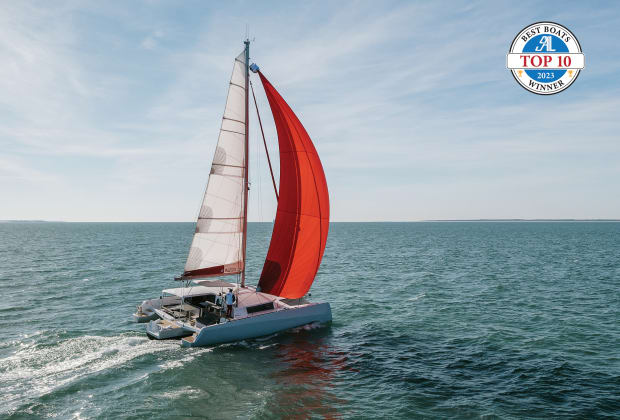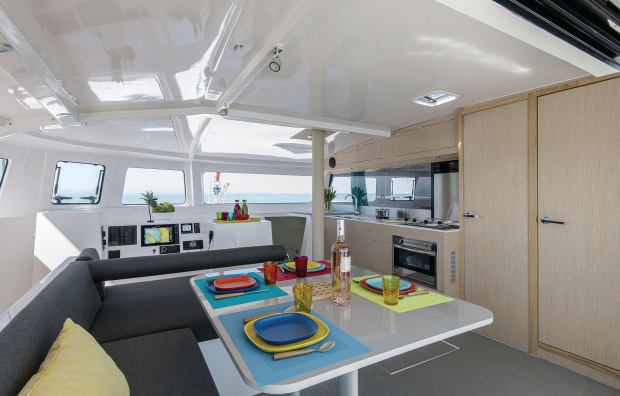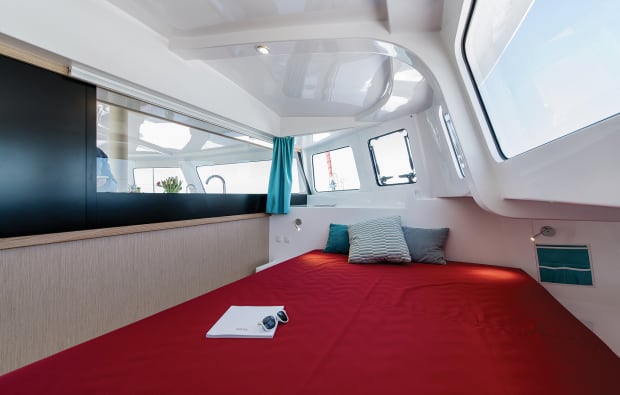
Photo by Olivier Blanchet, courtesy of Neel Trimarans
Just when monohull purists have become accustomed to catamarans, there’s a cosmic shift to three hulls. Trimarans certainly aren’t new, but their popularity is growing, especially with cruiser-friendly versions like the NEEL 43. The newest of the French builder’s family, the 43 combines the familiarity of a monohull with the stability of a cat, and it can outsail both.
The NEEL 43 is the work of designer Marc Lombard. The central hull supports the Z-Spar fractional rig balanced by the 5-foot fixed keel. From the side, the NEEL 43 looks like a catamaran with a sleek coachroof and a large aft cockpit.
The construction is a mix of approaches including a traditional foam/vinylester sandwich, carbon reinforcements in high-load areas, and a glass/flax cloth mix with a cork core in non-structural elements. That last part is a nod to the growing concept of greener boatbuilding, since flax and cork are actually recyclable.
The displacement is under 20,000 pounds, which is at least 2,000 pounds lighter than a comparable production catamaran. Between the lighter weight, the recyclable materials, and the single-engine propulsion, NEEL is at least trying to head in the direction of sustainability.
Another way the NEEL 43 offers more environmentally thoughtful sailing and cruising is the option to add an Integrel high-performance alternator that eliminates the need for a combustion-engine generator; a large bank of lithium-ion batteries for expanded energy storage; and a vast array of solar panels for passive regeneration. This new electrical system can keep owners autonomous at anchor for days at a time. It adds thousands to the price, but in the long term, it may be worth it for distance cruising.
Like a catamaran, the NEEL 43 does most of its living on the main deck and also has an elevated helm station on the bulkhead and twin trampolines at the bow. Walking forward is easy because the shrouds terminate into the coachroof and aren’t in the way, and the coachroof has a long, integrated channel that serves as a handhold.
The cockpit is the boat’s heart, since from here you can access either side deck, either transom, the helm, and the interior. It’s not clear why the designers chose to face the settee forward and toward the interior rather than aft toward the transom, but it works, and five can gather comfortably for meals. The tender is carried on a cradle on the swim platform of the central hull leaving two more mini platforms on the sides for additional water access.

Photo by Olivier Blanchet, courtesy of Neel Trimarans
Trimarans have never scored high on liveability, and that’s where the NEEL 43 took a new tack. The interior includes a generous salon with a central dinette to port and a compact galley in the forward starboard corner. The single head aft to starboard doubles as a wet locker. A nav station is forward to port; it cleverly shares a backrest with the dinette that is behind it.
The beauty is in the three cabins, two of which are on the side bridgedecks, so you’re never buried in the hull. Though enclosed, these cabins are visible to the main salon when their window shades are pulled back, so for privacy you need those drawn. When pulled back, though, the whole expanse of the boat is open, making the main salon seem even brighter and larger.
The third cabin is a few steps down in the bow of the central hull, and for most couples it will probably serve as a storage room (although we suspect that kids will love it). The overall finish and storage options are fairly basic, which keeps the weight down. It will also probably age well and require little maintenance.
The “basement” machinery space under the salon sole is cavernous and comprehensive, with every system well laid out and accessible. Regular maintenance won’t be a chore when you don’t have to origami yourself into the engine room.
When loaded up and going to weather, a trimaran will leave two wakes, because the windward ama lifts out of the water, minimizing wetted surface. At anchor or when sailing downwind, all three hulls make contact with the water, which brings blissful stability to the messiest of conditions.
We had a brisk breeze of 18-22 knots, and with the North Sails reacher on a top-down Facnor furler we kissed 11 knots speed over ground at 80 degrees apparent wind angle (AWA). Sneaking up to 40 degrees AWA in 18 knots of true wind, we sailed at 9.3 knots, and we still held 8.1 knots when sailing deep at 150 AWA. Although it’s possible to jibe without furling the headsail, it’s just easier to skip the pandemonium and furl.
Sightlines in all directions are excellent, as is the feel of the helm, which is on a Dyneema-and-block system (also supremely accessible behind a panel near the helm station). It’s truly like sailing a monohull but with the added stability of a cat.

Photo by Olivier Blanchet, courtesy of Neel Trimarans
Under power with the 50-hp diesel and saildrive, we motored 7.5 knots at 2,200 rpm. Options to consider include a carbon mast, which is 2 feet taller, a square-top mainsail, and a bow thruster for tight spots, especially when docking in reverse.
Trimarans make a lot of tradeoffs. Even with the NEEL design, a tri doesn’t have the room of a cat, and it doesn’t enjoy the same system redundancies since it’s basically a monohull with outriggers. That said, tris also have an advantage. They sail more like monohulls, able to point higher than cats with an easier motion, slicing through the waves rather than pounding into head seas.
With the introduction of this model in the mid-40-foot cruising sweet spot, NEEL is taking direct aim at experienced couples looking for speed, agility, and something a little different.
LOA 43’0”
Beam 24’7”
Draft 5’0”
Displacement 19,850 lbs
Sail Area 1,096 sq ft
Power 50-hp Volvo Penta diesel
Designer Marc Lombard
Builder NEEL Trimarans/neel-trimarans.com
Price as tested $575,000
May 2023








